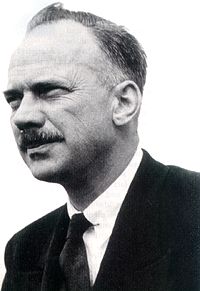By: Christine Hamelin
Ronald Way, Canada's top restorer of historic sites, brought Fort Henry to life.

Ronald was born in Kingston in 1908. His father taught engineering at Queen's University. As a child, Ronald read a lot and played in the ruins of Fort Henry. The family moved to Ottawa, but after his father died in 1924, they returned to Kingston, where Ronald enrolled at Kingston Collegiate.
Later, at Queen's, he studied prescience for a year but fell in love with history and graduated in 1935 with a bachelor of arts in Canadian history. He had intended to continue his education, but when the government decided to restore Fort Henry and required qualified researchers, Ronald was recommended because of his interest in military fortifications. Hired by the Ontario Government in 1936, he was responsible for the actual work and the research and imagination behind it.
In 1938, Queen's awarded him his master of arts, based on his work at the Fort, of which he became director. Between 1936 and 1939, he was extremely busy; he restored not only Fort Henry but also Fort George and Fort Niagara. He loved preserving the authentic feel of these fortifications and was thrilled to find bullets imprinted with teeth marks at Fort Erie, from a time when soldiers were operated on with no anaesthetic. When the restoration began, Fort Henry was little more than a pile of rubble after years of neglect. For two years, a thousand labourers toiled; it officially opened in 1938. A perfect example of fortress architecture reproduced from the original plans, Fort Henry became, and continues to be, a major tourist attraction.
Beryl Wynn Lewis - better known as "Taffy' - got a summer job working at the Fort. She became Ronald's assistant and then his wife and ended up as Executive Director of Fort Henry. The staff loved the Ways, who lived in the apartment inside the Fort, and spent part of each week, as well as summers, at the Upper Canada guesthouse. Weekends were spent at their farm in Prince Edward County, where they raised Holsteins.
Ronald, a quiet man with blue eyes and broad shoulders, was a great storyteller with an encyclopaedic knowledge of Canadian history. An active member of the Kingston Historical Society, he believed Canadian history was far from dry; he refused to allow embellishments of history, such as invented ghosts, at the Fort. One of Canada's first proponents of living museums - a term he lifted from a postcard that a nine-year-old had sent to him in the 1950s - he influenced scores of historians and curators. The best example of the innovative living-museum technique was the Fort Henry Guard, which Ronald considered his greatest contribution. He came up with the idea of having student volunteers, mostly from Queen's, wear mid-nineteenth century British uniforms and provide an authentic military presence. Ronald was deeply proud of the Guard, which he called "the best damned outfit on two legs to be found anywhere."
When Fort Henry was transferred to the Ontario St. Lawrence Parks Commission in 1958, so was Ronald, who became Director of Historic Buildings and Sites. In this capacity, he worked on Upper Canada Village, another example of animated history. He felt strongly that history should be accessible to all. In 1961, Ronald received Kingston's Honourable Achievement Award, presented to both him and Taffy, who always worked closely together.
Ronald was promoted to Director of Redevelopment and named as Reconstruction Consultant in the Ontario Department of Tourism. In addition to overseeing Fort Henry and Upper Canada Village, he restored Hamilton's Dundurn Castle, William Lyon Mackenzie's home at Queenstown and Joseph Brant's Burlington home. In 1961, the Prime Minister requested that he be loaned to the Federal Government to restore the town and fortress of Louisbourg, in Cape Breton. It was the largest historical reconstruction ever undertaken in Canada.
In 1965, Ronald resigned as an Ontario civil servant and became a consultant so that he could be more involved in the Louisbourg project. Known far beyond Canada as a prime consultant on historical restorations, he oversaw numerous projects. He was director of Fort Henry until 1970; in 1973, during a special ceremony, he was named an honorary Guardsman. In 1974, he received an honorary degree from Queen's. He died in 1978, just prior to the Fort's fortieth anniversary. An imaginative man committed to making history come alive, Ronald Way once noted, "It is our history, only, that makes Canadians different from Americans, who share the environment of this continent."
Reprint of an article that originally appeared in "Profile Kingston", January 12, 2000.